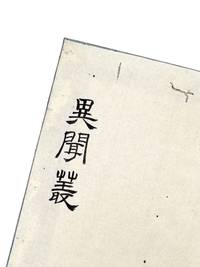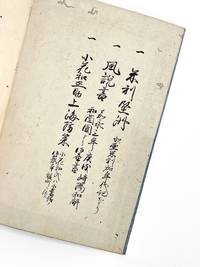IBUNSŌ [Collection of Exotic Tales]
- SIGNED
- [Japan]: n.p., 1853
[Japan]: n.p., 1853. Very good.. Manuscript collection of three foreign affairs reports documenting late-Edo Japan's intelligence gathering and strategic planning around the years of Commodore Perry's armed arrival in 1853. A rare primary source from an epochal turning point in world history. After word reached the Tokugawa shogunate of Perry's imminent expedition to pressure Japan into opening to wider foreign trade, information gathering on foreign affairs became suddenly critical to the security of the state. This manuscript is a copy of three documents relating directly to that moment: one from the years just before Perry's arrival, one from around the time of his arrival, and a final one responding to his arrival.
The earliest document (coming second in this collection), Kaei sannen kōjutsu betsudan fūsetsusho kiyō wakai, is an 1850 special report with recent news of foreign affairs from the years before Perry's first arrival — including the rumor that the United States might indeed be sending someone to open trade. Of particular interest is a description of California's gold rush, leading to an increase in population on the west coast of the US that put the shogunate ill at ease.
The next report (though first in the volume), Kita-Meriken Gasshūkoku kōshō, is a wide-ranging study of the United States for Japanese officials, spanning from Columbus's 1492 voyage to the 1853 arrival of Perry's black ships to Japan. It surveys the natural resources, geography, flora and fauna, commerce, and technology of the US, including whaling enterprises, steam engines, and that bizarre creature, the alligator.
The final document, Ohanawa Shōsuke jō kaibōsaku, speaks to the growing concerns of high-ranking officials: it is a proposal for coastal defense measures by Ohanawa Shōsuke, a hatamoto (a samurai directly responsible for the safety of the shogun), written in response to Perry's black ships. He argues against opening trade with the US and instead calls for strengthening defenses and attendant government reform.
A revealing material example of knowledge as power in the 19th century's quickly shifting international stage. 11'' x 7.75''. Original blue paper wrappers, fukuro-toji ("bound pocket book" style), strings renewed. Ink manuscript in Japanese; table of contents to first leaf, title to final leaf. 49 leaves. Paper title label largely effaced. Some insect damage to wrappers and leaves, light dampstaining to gutters. Wrappers with moderate wear and soil.
The earliest document (coming second in this collection), Kaei sannen kōjutsu betsudan fūsetsusho kiyō wakai, is an 1850 special report with recent news of foreign affairs from the years before Perry's first arrival — including the rumor that the United States might indeed be sending someone to open trade. Of particular interest is a description of California's gold rush, leading to an increase in population on the west coast of the US that put the shogunate ill at ease.
The next report (though first in the volume), Kita-Meriken Gasshūkoku kōshō, is a wide-ranging study of the United States for Japanese officials, spanning from Columbus's 1492 voyage to the 1853 arrival of Perry's black ships to Japan. It surveys the natural resources, geography, flora and fauna, commerce, and technology of the US, including whaling enterprises, steam engines, and that bizarre creature, the alligator.
The final document, Ohanawa Shōsuke jō kaibōsaku, speaks to the growing concerns of high-ranking officials: it is a proposal for coastal defense measures by Ohanawa Shōsuke, a hatamoto (a samurai directly responsible for the safety of the shogun), written in response to Perry's black ships. He argues against opening trade with the US and instead calls for strengthening defenses and attendant government reform.
A revealing material example of knowledge as power in the 19th century's quickly shifting international stage. 11'' x 7.75''. Original blue paper wrappers, fukuro-toji ("bound pocket book" style), strings renewed. Ink manuscript in Japanese; table of contents to first leaf, title to final leaf. 49 leaves. Paper title label largely effaced. Some insect damage to wrappers and leaves, light dampstaining to gutters. Wrappers with moderate wear and soil.


![IBUNSŌ [Collection of Exotic Tales]](https://d3525k1ryd2155.cloudfront.net/h/729/621/1626621729.0.x.jpg)



